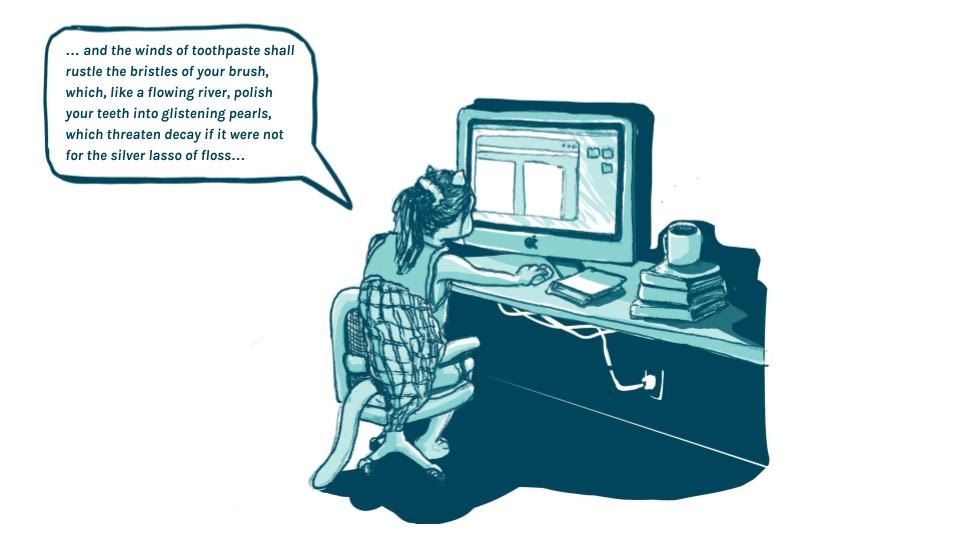Written by Maria Camasmie
August 31st, 2020
5 Effective Blog Writing Techniques Every Copywriter Needs to Know About

Blogging is one of the most integral forms of content writing. It draws potential clients into a brand’s world, establishes companies as trustworthy authorities in an industry, and helps construct a brand voice that is recognizable, approachable, and reliable.
So, how does a web copywriter take full advantage of this crucial content form?
Congratulations. You’ve stumbled upon the best blog for the job, which will take you through the top five most effective blog writing techniques—in the form of an effective blog (very meta, we know). Here’s a sneak peek:
- Get to the Point
- Focus on Conciseness
- Know the Audience, Know the Brand
- Format for Readability
- Pick a Theme—Even if There Isn’t One
Keep reading for a deep-dive into each writing technique used by most blog writing services and how you can integrate them into your own blogging toolbox.
#1: Get to The Point
We’re going to do a quick icebreaker here. Hey there, blog-writer! Meet, The Point. The Point, meet your writer!
The Point is the simplest answer to the prompt or question raised by the title of your blog article. For example, if your article is called “How to Brush Your Teeth,” then The Point is just that, how one brushes one's teeth.
The Point is very nice, albeit a bit direct, and readers love it. The Point is what readers come to see, after all.
However, The Point does not like being left to the end. It’s a bit of a diva like that.
The Point should be the guiding force of your article. While all blogs will eventually answer the question, the good ones—the ones readers keep reading—will give the audience exactly what they want as quickly as possible.
Don’t spend an entire blog building up to The Point. Instead, answer it immediately to satisfy the reader and then hook them in with the following:
- Your readable style and formatting
- Your engaging narrative
- A thematic throughline (see Technique #5)
- Answers to pertinent follow-up questions the reader may have
- Evidence to support The Point
The average internet user spends only 37 seconds on a blog post. That’s three seconds less than 40 seconds. And 40 seconds is a very short time. Most people click away because they haven't found what they wanted, while others just spend a few minutes skimming for relevant takeaways. That’s why you have to get to The Point early and effectively to capture the reader’s attention and keep them interested through well-formatted, narrative-driven prose.
#2: Focus on Conciseness
Style and voice are both important to blog writing. Vital, actually. No one wants to read boring articles chock-full of jargon and sucked dry of personality. However, you never want to let the lyricism of your prose get in the way of the more crucial aspects of your blog, which are:
- Informative content
- Readability
- Brand voice
- Audience appeal
- Approachability
- (Psst... The Point)
If you find that your blog is more Dickinson than direct, more Keats than catchy, you might need to refocus, hold back on the poetics, and aim for conciseness.
Here’s how you do it:
- Cut the Fluff – Are your sentences several lines long? Do you go on paragraph-long narratological tangents, chasing a metaphor that’s just beyond your grasp? If so, you might have a bit of a fluff problem. Fix it by cutting unnecessary words, metaphors, and tangents by constantly asking yourself: am I answering the question?
- Avoid Redundancies – Nothing is more wasteful—or boring—than saying the same thing over and over again. Here’s a good rule of thumb to avoid this: if a sentence is adding no more information than the previous one, then cut it.
- Use Style to Aid Content – While interesting stylistic choices make reading more fun, they can’t distract from the main blog content. If your style is making a sentence longer than it needs to be, take a more conservative approach. You can always pump up the voice in the editing stage.
- Use Powerful, Precise Words – Everyone loves a good adjective. However, using one word instead of two is always more efficient. As a general rule, if you can replace an adjective and a noun with a stronger noun, go for that one instead.
Remember, elaboration, voice, and a powerful adjective here and there are not the enemy. You just have to avoid using them at the expense of your reader’s attention and satisfaction.

#3: Know the Audience, Know the Brand
Would you ever reference famous ice hockey stars in a blog about meditation? Or would you make jokes about obscure nature sculptors in an article about preparing for a marathon?
You would never do that, right? That’s because the tone wouldn’t fit the brand voice or audience for those blogs. The point is, a good blog is one that answers the question in a way that is both on-brand and appealing to the target audience.
Here’s how you to figure out the audience and brand voice for your next blog article:
- Refer to brand content guidelines – Sometimes, the answer is right at your fingertips.
- Look through market research for that industry – What age-range, gender, or interests and hobbies does the brand cater to?
- Read through previous blogs – Do some friendly spying and adopt the language, idioms, and writing style that other blog writers have used for that company. You may even ask the client to pick out some of their favorites for you to draw inspiration from.
- Look through their website – Web copy is an excellent indicator of brand voice and audience because it's meant to be punchy and concise in very few words.
#4: Format for Readability
No one likes text walls. That is a proven fact. 100% of people dislike text walls. Citation needed.
When you write a blog, not only does the content have to be digestible, but so does the formatting. Giant paragraphs with little to no white space can make the reader feel a bit like a surfer right before they’re engulfed by the big wave from Point Break. And unless you’re Keanu Reeves, no one can handle such an intimidating force.
For aspiring copywriters, bloggers, and those that did not understand semi-obscure 1991 surfer movie references (check it out, Patrick Swayze’s in it, and he looks great), here are some quick writing tips for formatting an approachable and approachable blog:
- Bullet Points Are Your BFF – Use bullet-pointed lists to relay quantitative information like statistics and amounts. Also, use them if you find yourself listing items, qualities, steps, or criteria that start piling up on the page.
- Bullet Point Formatting – For lists with longer sentences and explanations, use a title-dash format (like this one) with spaces in between each item for clarity.
- Short and Sweet – Keep your paragraphs to four to five lines or less to avoid overwhelming the reader and to enforce conciseness.
- One-Liners – While one-liners rarely work at the bar, they do work in blogs. They’re punchy, they let the text breathe, and they’re great for nailing down a point.
- Whitespace – Disperse whitespace throughout your blog, such that even 2000+ words feel skimmable and readable.
- The Intro – The introduction is the reader’s first impression of what’s to come. Don’t take them through a giant exposition before getting to the point. Keep it short, snappy, and direct.
A readable format makes your blog more approachable and engaging. Not to mention, these added constraints help strengthen your writing skills and make the process more fun.
#5: Pick a Theme—Even if There Isn’t One
Now, this writing technique is a bit tricky. As mentioned before, your writing style shouldn’t overwhelm the blog content. However, you should try to infuse a narrative or thematic throughline into your blog without straying too far from The Point. A narrative engages readers, clarifies complex topics, and establishes brand voice.
Here are some examples of good throughlines and narratives to enrich your blog, without distracting from its content:
- Topic: Top 10 Best Cherry Pie Recipes for Cherry Fans
Theme: Making cherry pie is like picking the best players for a sports team.
- Topic: How to Find the Best Car Insurance in Your State
Theme: How finding car insurance is like speed dating.
- Topic: 5 Best Aliens from Space Jam
Theme: How picking your favorite Space Jam aliens is like choosing from a box of chocolates.
Sometimes, the client will supply a throughline for you—or, their brand is naturally attached to a certain theme or topic. In that case, you have it easy! Lean into what they give you and play with voice—not only will that please the reader and your client, but it’ll also make your job just that much more fun.
In Conclusion, Always Have a Conclusion
Ultimately, writing a successful blog is all about relaying pertinent information through a cohesive narrative, while staying focused and on-brand. While other forms of copywriting can be a bit more clinical, blog posts should be engaging, digestible, and memorable.
With blogs, you want your information to stick. That way, when you hit ‘em with a call to action (CTA) at the end, they’re more likely to perform said action.
So, you might be thinking: where is the CTA in this article?
Aha, how fast you do learn, young padawan. Here it is.
If you’ve found this blog compelling, know that there is an extremely talented, versatile, and—it’s worth mentioning—good-looking Copycat Copywriter behind the lush prose you’ve just consumed. If you’re interested in joining our ranks or hiring us for your next batch of blogs, be sure to reach out or sign up for a free piece of copy today!
Oh, and watch Point Break. Great film.
Sources:
99 Firms. Blogging Statistics. https://99firms.com/blog/blogging-statistics/#gref